BMW X5 PLUG-IN HYBRID 2023 Wheels and Tires
The wheels and tires package for the 2023 BMW X5 Plug-in Hybrid is the right combination of style, performance, and versatility. It also shows how committed the brand is to giving drivers a great experience. People with a wide range of tastes can get the X5 Plug-in Hybrid. It comes with a selection of wheel sizes and styles, including bigger wheels that can be added for a more commanding look on the road. Its tires, which come in a range of styles from all-season to performance-oriented, provide the best grip and handling in all kinds of driving situations. If you want the best in both form and function, the X5 Plug-in Hybrid is the best choice. Its wheels and tires are carefully designed to balance speed, comfort, and safety, whether you’re driving in the city or going off-road.
2023 BMW X5 Specs, Price, Features, Mileage (Brochure)
Vehicle features and options
This chapter describes all standard, country-specific and optional features offered with the series. It also describes features and functions that are not necessarily available in your vehi-cle, e.g., due to the selected options or country versions. This also applies to safety-related functions and systems. When using these functions and systems, the applicable laws and regulations must be observed.
Tire pressure
General information
The tire condition and tire pressure influence the following:
- The service life of the tires.
- Driving safety.
- Driving comfort.
- Fuel consumption.
Safety information
Warning
A tire with too little or no tire inflation pressure may heat up significantly and sustain damage. This will have a negative impact on aspects of handling, such as steering and braking response. There is a risk of an accident. Regularly check the tire inflation pressure, and correct it as needed, for instance twice a month and before a long trip.
Tire pressure specifications
In the tire inflation pressure table
The tire inflation pressure table contains all tire inflation pressure specifications for the specified tire sizes at ambient temperature. The tire inflation pres-sure values apply to tire sizes approved by the manufacturer of the vehicle for the vehicle type.
To identify the correct tire inflation pressure, please note the following:
- Tire sizes of your vehicle.
- Maximum speed for driving.
On the control display
The current tire inflation pressure values and the intended tire inflation pressure values for the mounted tires can be displayed on the Control Display.
To ensure that they are displayed correctly, the tire sizes must be stored in the system and must have been set for the mounted tires.
The current tire inflation pressure value is located on each tire.
The reference tire inflation pressure value is located in the lower area of the control display.
Checking the tire pressure
General information
Tires heat up while driving. The tire pressure increases with the tire temperature.
Tires have a natural, consistent tire pressure loss.
The displays of inflation devices may be under-read by up to 0.1 bar/2 psi.
Checking using tire inflation pressure specifications in the tire inflation pressure table
- Determine the intended tire inflation pressure levels for the mounted tires.
- Check the tire inflation pressure in all four tires, using a pressure gage, for example.
- Correct the tire inflation pressure if the ac-tual tire inflation pressure deviates from the intended tire inflation pressure.
- Check whether all valve caps are screwed onto the tire valves.
The tire inflation pressure specifications in the tire inflation pressure table only relate to cold tires or tires at the same temperature as the ambient temperature.
Only check the tire inflation pressure levels when the tires are cold, i.e.:- A distance traveled of max. 1.25 miles/2 km has not been exceeded.
- If the vehicle has not moved again for at least 2 hours after a trip.
Checking using the tire inflation pressure specifications on the Control Display
- CAR”
- Vehicle status”
 Tire Pressure Monitor”
Tire Pressure Monitor”- Check whether the current tire inflation pressure levels deviate from the intended tire pressure value.
- Correct the tire inflation pressure if the actual tire inflation pressure deviates from the intended tire inflation pressure.
The display of the current tire pressure may be limited when the vehicle is stationary. After a short drive, the tire pressure is updated.
After correcting the tire pressure
For the flat tire monitor:
Reinitialize the Flat Tire Monitor.
With Tire Pressure Monitor:
The corrected tire inflation pressures are applied automatically. Make sure that the correct tire settings have been made.
With tires that cannot be found in the tire pres-sure values on the control display, reset the Tire Pressure Monitor (TPM).
Tire inflation pressures up to 100 mph/160 km/h
For speeds of up to 100 mph/160 km/h and for optimum driving comfort, note the pressure values in the tire inflation pressure table and adjust as necessary.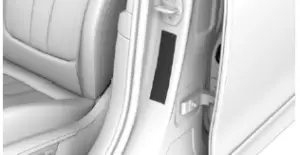
These pressure values can also be found on the tire pressure label on the driver’s door pil-lar.
Do not exceed a speed of 100 mph/160 km/h.
Tire inflation pressures at max. speeds above 100 mph/160 km/h
Warning
In order to drive at maximum speeds in excess of 100 mph/160 km/h, please observe and, if necessary, adjust tire pressures for speeds exceeding 100 mph/160 km/h from the relevant table on the following pages. Otherwise, tire damage and accidents could occur.
For speeds over 100 mph/160 km/h and for optimum driving comfort, note the pressure values in the tire inflation pressure table and adjust as necessary.
Tire marking
Tire size
245/45 R 18 96 Y
245: nominal width in mm
45: cross-sectional relationship in %
R: radial tire code
18: rim diameter in inches
96: load bearing capacity
Y: speed code letter
ZR tires: reinforced radial tire for speeds exceeding 150 mph/240 km/h
Maximum tire load
Maximum tire load is the maximum permissible weight for which the tire is approved.
Locate the maximum tire load on the tire sidewall and the Gross Axle Weight Rating –GAWR – on the certification label on the driver door B-pillar. Divide the tire load by 1.1. It must be greater than one-half of the vehicle’s Gross Axle Weight Rating – GAWR. Note, front vs. rear GAWR and tire loads, respectively.
Tire Identification Number
DOT code: DOT xxxx xxx 1922
xxxx: manufacturer code for the tire brand xxx: tire size and tire design
1922: tire age
Tires with DOT codes meet the guidelines of the U.S. Department of Transportation.
Tire age
Recommendation
Regardless of the tire tread depth, replace tires at least every 6 years.
Manufacture date
You can find the manufacture date of the tire on the tire sidewall.
Designation Manufacture date
DOT … 1922 19th week 2022
Uniform Tire Quality Grading
Quality grades can be found where applicable on the tire sidewall between tread shoulder and maximum section width.
E.g.: Treadwear 200; Traction AA; Temperature A
DOT Quality Grades
Treadwear
Traction AA A B C
Temperature A B C
All passenger vehicle tires must conform to Federal Safety Requirements in addition to these grades.
Treadwear
The treadwear grade is a comparative rating based on the wear rate of the tire when tested under controlled conditions on a specified government test course. E.g., a tire graded 150 would wear one and one-half, 1 g, times as well on the government course as a tire graded 100. The relative performance of tires depends upon the actual conditions of their use, however, and may depart significantly from the norm due to variations in driving habits, service practices and differences in road characteristics and climate.
Traction
The traction grades, from highest to lowest, are AA, A, B, and C.
Those grades represent the tire’s ability to stop on wet pavement as measured under controlled conditions on specified government test surfaces of asphalt and concrete. A tire marked C may have poor traction performance.
The traction grade assigned to this tire is based on straight-ahead braking traction tests, and does not include acceleration, cornering, hydroplaning, or peak traction characteristics.
Temperature
The temperature grades are A, the highest, B, and C, representing the tire’s resistance to the generation of heat and its ability to dissipate heat when tested under controlled conditions on a specified indoor laboratory test wheel. Sustained high temperature can cause the material of the tire to degenerate and reduce tire life, and excessive temperature can lead to sudden tire failure. The grade C corresponds to a level of performance that all passenger car tires must meet under the Federal Motor Vehicle Safety Standard No. 109. Grades Band A represents higher levels of performance on the laboratory test wheel than the minimum required by law.
Warning
The temperature grade for this tire is established for a tire that is properly inflated and not overloaded. Excessive speed, underinflation, or excessive loading, either separately or in combination, can cause heat buildup and possible tire failure.
Runflat tires
Runflat tires, are labeled with a circular icon containing the letters RSC marked on the tire sidewall.
M+S Winter and all-season tires with better cold-weather performance than summer tires.
Tire tread
Summer tires
Do not drive with a tire tread depth of less than 0.12 in/3 mm, otherwise, there is an increased risk of aquaplaning.
Winter tires
Do not drive with a tire tread depth of less than 0.16 in/4 mm, as such tires are less suitable for winter driving conditions.
Minimum tread depth
Distributed over the tire circumference are the tire manufacturer’s wear indicators with a height of at least 0.06 in/1.6 mm, which serve as an indicator of tire tread wear.
The positions of the wear indicators are marked on the tire sidewall with TWI, Tread Wear Indicator.
Irrespective of the wear indicators, observe the statutory regulations on the minimum tread depth.
Tire damage
General information
Check your tires regularly for damage, foreign bodies lodged in the tread, and tread wear.
Driving over rough or damaged road surfaces, as well as debris, curbs and other obstacles can cause serious damage to wheels, tires and suspension parts. This is more likely to occur with low-profile tires, which provide less cushioning between the wheel and the road. Be careful to avoid road hazards and reduce your speed, especially if your vehicle is equipped with low-profile tires.
Indications of tire damage or other vehicle mal-functions:
- Unusual vibrations.
- Unusual tire or running noises.
- Unusual handling such as a strong tendency to pull to the left or right.
- Uneven wear pattern, e.g., increased wear in the area of the tire shoulder.
Damage can be caused by the following situations, for instance: - Driving over curbs.
- Road damage.
- Tire pressure too low.
- Vehicle overloading.
- Incorrect tire storage.
Safety information
Warning
Damaged tires can lose tire inflation pressure, which can lead to loss of vehicle con-trol. There is a risk of an accident. If tire damage is suspected while driving, immediately reduce speed and stop. Have wheels and tires checked. For this purpose, drive carefully to the nearest authorized service center or another qualified service center or repair shop. Have vehicle towed or transported as needed. Do not repair damaged tires, but have them replaced.
Warning
Tires can become damaged by driving over obstacles, e.g., curbs or road damage, at high speed. Larger wheels have a smaller tire cross-section. The smaller the tire cross-sec-tion, the higher the risk of tire damage. There may be a risk of accidents and risk of damage to property. If possible, avoid driving over objects or road conditions that may damage tires, or drive over them slowly and carefully.
Exchanging wheels and tires
Mounting and wheel balancing
Have mounting and wheel balancing carried out by an authorized service center or another qualified service center or repair shop.
Approved wheels and tires
General information
The following sizes are recommended and approved by the vehicle manufacturer for the approved wheels and tires per vehicle type and special equipment:
- Wheel and tire combinations.
- Rim designs.
- Tire sizes.
- Tire brands.
You can ask an authorized service center or another qualified service center or repair shop about the approved wheels and tires for the vehicle and the special equipment..
Safety information
Warning
Wheels and tires which are not suitable for your vehicle can damage parts of the vehicle, for instance, due to contact with the body due to tolerances despite the same official size rating. There is a risk of an accident. The manufacturer of your vehicle strongly suggests that you use wheels and tires that have been recommended by the vehicle manufacturer for your vehicle type.
Warning
Mounted steel wheels can cause technical problems, for instance, unexpected loosening of the lug bolts and damage to the brake disks. There is a risk of accident. Do not mount steel wheels.
Warning
Incorrect wheel/tire combinations will impair the vehicle’s handling characteristics and a variety of system functions, such as the Antilock Braking System or Dynamic Stability Control. There is a risk of an accident. To maintain good handling and vehicle response, use only tires with a single tread configuration from a single manufacturer. The manufacturer of the vehicle recommends that you use wheels and tires that have been recommended by the vehicle manufacturer for your vehicle type. Following tire damage, have the original wheel/tire combination remounted on the vehicle as soon as possible.
Warning
Unsuitable wheel studs, such as single-sec-tion wheel studs, may loosen or come off. The wheel may come loose during driving. There is a risk of an accident. Use only two-sec-tion wheel studs that have been categorized as suitable for the respective wheel type by the manufacturer of the vehicle.
Recommended tire brands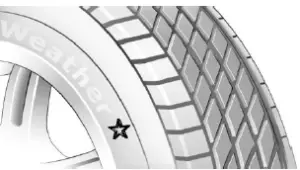
For each tire size, the manufacturer of the ve-hicle recommends certain tire brands. The tire brands can be identified by a star on the tire sidewall.
New tires
Tire traction is not optimal due to manufacturing circumstances when tires are brand new.
Drive conservatively for the first 200 miles/300 km.
Retreaded tires
Warning
Retreated tires can have different tire casing structures. With advanced age the service life can be limited. There is a risk of an accident. The manufacturer of the vehicle does not recommend the use of retreaded tires.
Winter tires
General information
Winter tires are recommended for operating on winter roads.
Winter tires can be identified by the icon with mountain and snowflake, as well as the M+S marking on the tire sidewall.
All-season tires with the M+S designation, but without icon with mountain and snowflake, have better winter characteristics than summer tires but generally do not achieve the performance of winter tires.
Maximum speed of winter tires
If the maximum speed of the vehicle is higher than the permissible speed for the winter tires, then attach a sign showing the permissible maximum speed in the field of vision. The sign is available from an authorized service center or another qualified service center or repair shop.
With winter tires mounted, observe and do not exceed the permissible maximum speed.
Changing run-flat tires
When changing from run-flat tires to standard tires, it must be ensured that the vehicle contains an emergency wheel or tire mobility kit. Further information is available from an authorized service center or another qualified service center or repair shop.
Wheel change between axles
Warning
A wheel change between the axles on vehicles with different tire sizes or rim sizes on the front and rear axles can cause damage to the tires and the vehicle. There is a risk of accident. Do not rotate the tires between the axles on vehicles with different tire sizes or rim sizes on the front and rear axles.
Different abrasion patterns can occur on the front and rear axles depending on individual driving conditions. The tires can be rotated in pairs between the axles to achieve even abra-sion. Further information is available from an authorized service center or another qualified service center or repair shop. After changing, check the tire pressure and correct, if needed.
Storing tires
Tire pressure
Do not exceed the maximum tire inflation pressure indicated on the tire sidewall.
Storage
- Store wheels and tires in a cool, dry and dark place.
- Always protect tires against all contact with oil, grease, and solvents.
- Do not leave tires in plastic bags.
- Remove dirt from wheels or tires.
Runflat tires
Principle
Runflat tires permit continued driving under limited conditions even in the event of a complete tire pressure loss.
General information
The wheels consist of tires that are self-sup-porting to a limited degree and may also include special rims.
The reinforcement of the sidewall allows the tire to remain drivable to a limited degree in the event of a tire pressure loss.
Follow the instructions for continued driving with a flat tire.
Safety information
Warning
The vehicle handles differently when a run-flat tire has insufficient or no tire pressure; for instance, reduced directional stability when braking, braking distances are longer and the self-steering properties will change. There is a risk of an accident. Drive moderately and do not exceed a speed of 50 mph/80 km/h.
Warning
Heavy trailers can start swinging when continuing to drive with a flat tire. There may be a risk of accident or risk of damage to property. Do not exceed a speed
of 35 mph/60 km/h when driving with a trailer and a flat tire. Immediately brake in the case of swinging. Apply necessary steering corrections as carefully as possible.
Identification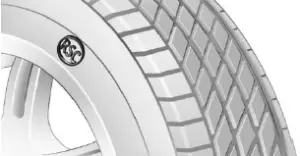
Runflat tires are labeled with a circular icon containing the letters RSC marked on the tire sidewall.
Repairing a flat tire
Safety precautions
- Park the vehicle as far away as possible from passing traffic and on solid ground.
- Turn on the hazard warning system.
- Secure the vehicle against rolling away by setting the parking brake.
- Turn the steering wheel until the front wheels are in the straight-ahead position and engage the steering wheel lock. Have all vehicle occupants get out and make sure that they remain outside the hazardous area such as behind a guardrail.
- If necessary, set up a warning triangle at an appropriate distance.
Tire repair set
Principle
With the tire repair set, minor tire damage can be sealed temporarily to enable continued driving.
General information
- To enable continued driving, liquid sealant is pumped into the tire, which hardens and seals the damage from the inside.
- Follow the instructions on using the tire re-pair set found on the compressor and sealant bottle.
- The use of a tire repair set can be ineffective if the tire puncture measures above ap-prox. 0.16 in/4 mm.
- Contact an authorized service center or another qualified service center or repair shop if the tire cannot be made drivable.
- Do not remove foreign objects that have penetrated the tire. Remove foreign objects only when they are visibly protruding from the tire.
- Detach the speed limit sticker from the sealant bottle and apply it to the steering wheel.
- The use of a sealing compound can damage the wheel electronics. In this case, have the electronics checked and replaced at the next opportunity.
- The compressor can be used to check the tire inflation pressure.
2023 BMW X5 Specs, Price, Features, Mileage (Brochure)
Overview
Storage 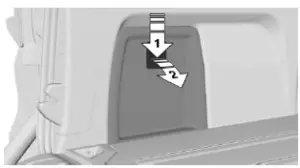
The storage for the tire repair set is provided in the cargo area behind the left-side trim panel. Unlock the cover of the left side trim panel, arrow 1, and fold open, arrow 2.
Sealant bottle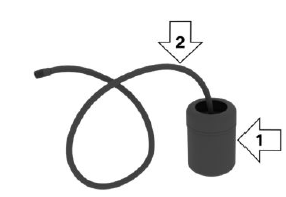
- Sealant bottle, arrow 1.
- Filler hose, arrow 2.
Observe expiration date on the sealant bottle.
Compressor 
- Sealant bottle unlocking
- Sealant bottle mount
- Tire pressure display
- Reduce tire inflation pressure button 5 On/off switch
- Compressor
- Connector/cable for socket
- Connection hose
Safety precautions
- Park the vehicle as far away as possible from passing traffic and on solid ground.
- Turn on the hazard warning system.
- Secure the vehicle against rolling away by setting the parking brake.
Turn the steering wheel until the front wheels are in the straight-ahead position and engage the steering wheel lock. - Have all vehicle occupants get out and make sure that they remain outside the hazardous area such as behind a guardrail.
- If necessary, set up a warning triangle at an appropriate distance.
Filling the tire with sealing compound
Safety information
DANGER
If the exhaust pipe is blocked or ventilation is insufficient, harmful exhaust gases can penetrate the vehicle. The exhaust gases contain pollutants that are colorless and odorless. In enclosed areas, exhaust gases can also accumulate outside of the vehicle. There is a danger to life. Keep the exhaust pipe free and ensure sufficient ventilation.
NOTICE
The compressor can overheat during extended operation. There is a risk of damage to property, among other potential damage. Do not run the compressor for more than 10 minutes.
Filling
- Shake the sealant bottle.

- Pull filler hose completely out of the cover of the sealant bottle. Do not kink the hose.
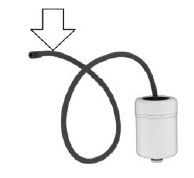
- Slide the sealant bottle into the mount on the compressor housing, ensuring that it engages audibly.

- 4. Screw the filler hose of the sealant bottle onto the tire valve of the faulty wheel.

- With the compressor switched off, insert the connector into the power socket in the vehi-cle interior.

- With standby state or drive-ready state switched on, switch on the compressor.
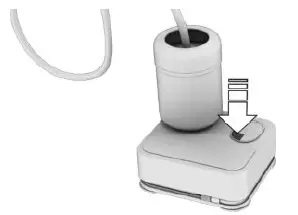
Let the compressor run for a maximum of 10 minutes to fill the tire with sealant and reach a tire pressure of approx. 2 bar.
While the tire is being filled with sealing compound, the tire inflation pressure may sporadically reach approx. 5 bar. Do not switch off the compressor in this phase.
Checking and adjusting the tire inflation pressure
Checking
- Switch off the compressor.
- Read the tire pressure on the tire pressure display.
To continue the trip, a tire pressure of at least 2 bar must be reached.
Removing and stowing the sealant bottle
- Unscrew the filler hose of the sealant bottle from the tire valve.
- Press the red unlocking device.
- Remove the sealant bottle from the compressor.
- Wrap and store the sealant bottle in suitable material to avoid contamination of the cargo area.
Minimum tire inflation pressure is not reached
- Pull the connector out of the power socket in the vehicle interior.
- Drive 33 ft/10 m forward and back to distribute the sealing compound in the tire.
- Screw the connection hose of the compressor directly onto the tire valve stem.
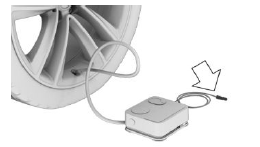
- Insert the connector into the power socket in the vehicle interior.

- With standby or drive readiness turned on, turn on the compressor and let it run for a maximum of 10 minutes.
When the tire pressure does not reach at least 2 bar, contact an authorized service center or another qualified service center or repair shop.
When a tire pressure of at least 2 bar is reached, see Minimum tire inflation pressure is reached. - Unscrew the connection hose of the compressor from the tire valve.
- Pull the connector out of the power socket in the vehicle interior.
- Stow the tire repair set in the vehicle.
Minimum tire inflation pressure is reached
- Unscrew the connection hose of the compressor from the tire valve.
- Pull the connector out of the power socket in the vehicle interior.
- Stow the tire repair set in the vehicle.
- Immediately drive approx. 5 miles/10 km to ensure that the sealing compound is evenly distributed in the tire.
Do not exceed a speed of
50 mph/80 km/h.
If possible, do not drive at speeds less than 12 mph/20 km/h.
Adjustment
- Stop at a suitable location.
- Screw the connection hose of the compressor directly onto the tire valve stem.

- Insert the connector into the power socket in the vehicle interior.

- Correct the tire pressure to at least 2 bar:
- Increase tire pressure: with standby or drive readiness turned on, turn on the compressor and let it run for a maximum of 10 minutes.
- Reduce tire inflation pressure: press the button on the compressor.
- Unscrew the connection hose of the compressor from the tire valve.
- Pull the connector out of the power socket in the vehicle interior.
- Stow the tire repair set in the vehicle.
Continuing the trip
Do not exceed the permissible maximum speed of 50 mph/80 km/h.
Reinitialize the Flat Tire Monitor.
Reset the Tire Pressure Monitor again.
Replace the faulty tire and the sealant bottle of the tire repair set promptly.
Tire chains
Safety information
Warning
Mounting tire chains on unsuitable tires can cause the tire chains to come into contact with vehicle parts. There may be a risk of accident or risk of damage to property. Only mount tire chains on tires that are designated by their manufacturer as suitable for the use of tire chains.
Warning
Insufficiently tight tire chains may damage tires and vehicle components. There may be a risk of accident or risk of damage to prop-erty. Make sure that the tire chains are al-ways sufficiently tight. Re-tighten as needed according to the tire chain manufacturer’s instructions.
Fine-link tire chains
The manufacturer of the vehicle recommends the use of fine-link tire chains. Certain types of fine-link tire chains have been tested by the manufacturer of the vehicle and recommended as road-safe and suitable.
Information regarding suitable tire chains is available from an authorized service center or another qualified service center or repair shop.
Use
Use only in pairs on the rear wheels, equipped with the tires of the following size:
- 265/50 R19.
275/45 R20.
Information on the wheel size and rim offset is located on the inside of the wheel.
The list can also include wheel/tire sizes that are only suitable for certain models.
Information about approved wheels and tires for the vehicle can be requested from an authorized service center or another qualified service center or repair shop.
Follow the tire chain manufacturer’s instructions.
Do not initialize the flat tire monitor after mounting tire chains, as doing so may result in incorrect readings.
Do not reset the Tire Pressure Monitor after mounting tire chains, as doing so may result in incorrect readings.
When driving with tire chains, activate the Dynamic Traction Control briefly to optimize the drive power.
Maximum speed with tire chains
Do not exceed a speed of 30 mph/50 km/h when using tire chains.
Rear axle steering during operation with snow chains
General information
In order to guarantee free movement of the wheels when operating with tire chains, rear axle steering of the integral active steering must be switched off when tire chains are mounted.
Safety information
Warning
When rear-axle steering is switched on and tire chains are mounted, there can be contact between tire chains and the body. There may be a risk of accident or risk of damage to property. With mounted tire chains, switch off the rear axle steering.
Switching off rear axle steering
The rear axle steering is switched off by specifying that tire chains are installed.
- CAR”
- Settings”
- General settings”
- Tire chains”
- Tire chains installed”
Starting with the permissible maximum speed with snow chains of 30 mph/50 km/h the rear axle steering will be switched on again automatically.
Tire pressure monitor
Principle
The Tire Pressure Monitor monitors the tire pressure and issues a warning if the tire pressure has dropped.
General information
Sensors in the tire valves measure the tire inflation pressure and tire temperature.
Depending on the tires detected or registered, the system displays the specified nominal pressures on the control display and compares them with the current tire pressures.
If tires are being used that are not specified in the tire inflation pressure details on the vehicle, such as tires with special approval, the system needs to be actively reset. The system will then take over the actual tire inflation pressures as the target pressures.
When operating the system, also note the information found in the Tire inflation pressure chapter.
Safety information
Warning
The display of the target pressures is not a substitute for the tire inflation pressure de-tails on the vehicle. Incorrect entries in the tire settings can lead to incorrect target tire inflation pressure values. In this case, it cannot be guaranteed that the notification of a tire pressure loss will be reliable. There is a risk of injury and risk of damage to property. Ensure that the tire sizes of the mounted tires are displayed correctly and match the details on the tires and on the vehicle.
Functional requirements
The following prerequisites must be met for the system; otherwise, reliable notification of a tire pressure loss is not assured:
- Every time a tire or wheel is changed, the correct details on the mounted tires must be entered in the tire settings.
- The Tire Pressure Monitor does not activate until after driving for a few minutes:
- After a tire or wheel change.
- After a reset, for tires with special approval.
- After changing the tire setting.
- For tires with special approval:
- After a tire or wheel change, a reset was performed with the correct tire inflation pressure.
- After the tire inflation pressure was adjusted to a new value, a reset was performed.
- Wheels with wheel electronics.
Tire settings
General information
The tire sizes of the mounted tires can be gathered from the tire inflation pressure details on the vehicle or directly on the tires.
The tire details do not need to be re-entered when the tire pressure is corrected.
For summer and winter tires, the tire details entered last are stored. After a tire or wheel change, the settings of the tire sets used last can be selected.
Changing settings
- CAR”
- Vehicle status”
- Tire Pressure Monitor”
- Tire settings”
- Tire selection”
- Manual”
- Tire type”
- Select the tire type that is mounted on the rear axle.
For tires with special approval:
“Other tires”
Observe further proceeding in the perform a reset section.
9. Select the maximum road speed that will be used with the tires.
10. “Save tire settings”
The measurement of the current tire inflation pressure is started. The measurement process is displayed.
Status display
Current status
The system status can be displayed on the Control Display, e.g., whether or not the sys-tem is active.
- CAR”
- Vehicle status”
 Tire Pressure Monitor”
Tire Pressure Monitor”
The current status is displayed.
Current tire pressure
The current tire pressure is displayed for each tire.
The current tire inflation pressures may change during driving or depending on the outside temperature.
Current tire temperature
Depending on the model, the current tire temperatures are displayed.
The current tire temperatures may change while driving or due to the outside temperature.
Nominal pressure
The nominal pressure for the tires on the front and rear axles is displayed.
The specified nominal pressures take the influence of driving and outside temperature on the tire temperature into account. The appropriate nominal pressure is always displayed, independent of the weather situation, tire temperatures and travel times.
The displayed nominal pressure may change and may differ from the tire inflation pressure details on the door pillar of the driver’s door. The tire inflation pressure can thus be correlated to the value of the displayed target pressures. The nominal pressure is immediately adjusted if the vehicle load status is changed in the tire settings.
Tire conditions
General information
Tire and system status are indicated by the color of the wheels and a text message on the control display.
Any existing messages may not be deleted if the nominal pressure is not reached after the tire inflation pressure is corrected.
All wheels green
- The system is active and bases warnings on the target pressures.
- For tires with special approval: the system is active and bases warnings on the tire inflation pressures stored during the last re-set.
One to four yellow wheels
A flat tire or major tire pressure loss has occurred in the indicated tires.
Gray wheels
It may not be possible to identify tire pressure losses.
Possible causes:
- Malfunction.
- During tire inflation pressure measurement, after confirmation of the tire settings.
- For tires with special approval: a reset is performed for the system.
For tires with special approval: performing a reset
- CAR”
- Vehicle status”
- Tire Pressure Monitor”
- Make sure that the correct tire settings have been made.
- Turn on the drive-ready state and do not drive off.
- Reset tire pressure: “Perform reset”.
- Drive off.
The wheels are displayed in gray and the following is displayed: “Resetting tire pressure…”.
After a travel time of several minutes, the set tire inflation pressures are accepted as the predefined tire inflation pressures. The reset is completed automatically while driving.
After a successfully completed reset, the wheels on the control display are shown in green and the following is displayed: “Reset successful.”
You may interrupt this trip at any time. When you continue driving the reset resumes automatically.
Messages: for tires without special approval
General information
When a flat tire is indicated, the Dynamic Stability Control may be turned on.
Safety information
Warning
A damaged regular tire with low or no tire inflation pressure impacts handling, such as steering and braking response. Runflat tires can maintain limited stability. There is a risk of an accident. Do not continue driving if the vehicle is equipped with normal tires. Follow the information on run-flat tires and continue driving with these tires.
If a tire inflation pressure check is required
Message
An icon with a Check Control message appears on the control display.
Icon Possible cause Inflation was not carried out according to specifications, for instance when the tire has not been sufficiently inflated or in the case of a natural steady tire pressure loss.
Inflation was not carried out according to specifications, for instance when the tire has not been sufficiently inflated or in the case of a natural steady tire pressure loss.
Measure
Check the tire pressure and correct as needed.
If the tire inflation pressure is too low
Message
 A yellow warning light is illuminated in the instrument cluster.
A yellow warning light is illuminated in the instrument cluster.
In addition, an icon with a Check Control message appears on the control display.
Icon Possible cause There is a tire pressure loss.
There is a tire pressure loss.
Measure
- Reduce the vehicle speed. Do not exceed a speed of 80 mph/130 km/h.
- At the next opportunity, for instance, at a filling station, check the tire inflation pressure in all four tires and correct if necessary.
If there is a significant tire pressure loss
Message
 A yellow warning light is illuminated in the instrument cluster.
A yellow warning light is illuminated in the instrument cluster.
In addition, an icon with the affected tire appears in a Check Control message on the con-trol display.
Icon Possible cause![]() There is a flat tire or a major tire pressure loss.
There is a flat tire or a major tire pressure loss.
Measure
- Reduce your speed and stop cautiously. Avoid sudden braking and steering maneuvers.
- Check whether the vehicle is fitted with standard tires or runflat tires.
Runflat tires are labeled with a circular icon containing the letters RSC marked on the tire sidewall. - Read the description on what to do in case of a flat tire.
Messages: for tires with special approval
General information
When a flat tire is indicated, the Dynamic Stability Control may be turned on.
Safety information
Warning
A damaged regular tire with low or no tire inflation pressure impacts handling, such as steering and braking response. Runflat tires can maintain limited stability. There is a risk of accident. Do not continue driving if the vehicle is equipped with normal tires. Follow the information on runflat tires and continue driving with these tires.
If a tire inflation pressure check is required
Message
An icon with a Check Control message appears on the control display.
Icon Possible cause Inflation was not carried out according to specifications, e.g., the tire has not been sufficiently inflated.
Inflation was not carried out according to specifications, e.g., the tire has not been sufficiently inflated.
The system has detected a wheel change, but no reset was done.
The tire inflation pressure has fallen below the level of the last reset.
No reset was performed for the sys-tem. The system issues a warning based on the tire inflation pressures stored during the last reset.
Measure
- Check the tire pressure and correct as needed.
- Perform a system reset.
If the tire inflation pressure is too low
Message
 A yellow warning light is illuminated in the instrument cluster.
A yellow warning light is illuminated in the instrument cluster.
In addition, an icon with a Check Control message appears on the control display.
Icon Possible cause There is a tire pressure loss.
There is a tire pressure loss.
No reset was performed for the sys-tem. The system issues a warning based on the tire inflation pressures stored during the last reset.
Measure
- Reduce the vehicle speed. Do not exceed a speed of 80 mph/130 km/h.
- At the next opportunity, for instance, at a filling station, check the tire inflation pressure in all four tires and correct if necessary.
- Reset the system.
If there is a significant tire pressure loss
Message
 A yellow warning light is illuminated in the instrument cluster.
A yellow warning light is illuminated in the instrument cluster.
In addition, an icon with the affected tire ap-pears in a Check Control message on the con-trol display.
Icon Possible cause
There is a flat tire or a major tire pressure loss.
No reset was performed for the sys-tem. The system issues a warning based on the tire inflation pressures stored during the last reset.
Measure
- Reduce your speed and stop cautiously. Avoid sudden braking and steering maneuvers.
- Check whether the vehicle is fitted with standard tires or runflat tires.
Runflat tires are labeled with a circular icon containing the letters RSC marked on the tire sidewall. - Read the description on what to do in case of a flat tire.
Actions in the event of a flat tire
Standard tires
- Identify the damaged tire.
Check the tire pressure in all four tires, for instance using the tire pressure display from a tire repair set.
For tires with special approval: when the tire pressure in all four tires is correct, the Tire Pressure Monitor may not have been reset. In this case, perform the reset.
If tire damage cannot be found, contact an authorized service center or another qualified service center or repair shop. - Repair the flat tire, for instance with a tire repair set or by changing the wheel.
Using a sealing compound, for instance, from the tire repair set, may damage the wheel electronics. Have the electronics replaced at the next opportunity?
Runflat tires
Safety information
Warning
The vehicle handles differently when a runflat tire has insufficient or no tire pressure; for instance, reduced directional stability when braking, braking distances are longer and the self-steering properties will change. There is a risk of an accident. Drive moderately and do not exceed a speed of 50 mph/80 km/h.
Warning
Heavy trailers can start swinging when continuing to drive with a flat tire. There may be a risk of accident or risk of dam-age to property. Do not exceed a speed
of 35 mph/60 km/h when driving with a trailer and a flat tire. Immediately brake in the case of swinging. Apply necessary steering corrections as carefully as possible.
Maximum speed
You may continue driving with a damaged tire at speeds up to 50 mph/80 km/h.
Continued driving with a flat tire
Follow the following when continuing to drive with a damaged tire:
- Avoid sudden braking and steering maneuvers.
- Do not exceed a speed of 50 mph/80 km/h.
- Check the tire inflation pressure in all four tires at the next opportunity.
Possible distance traveled with a depressurized tire
The possible distance that may be safely traveled varies depending on how the vehicle is loaded and used, e.g., speed, road condi-tions, outside temperature. The distance traveled may be less but may also be more if an economical driving style is used.
If the vehicle is loaded with an average weight and used under favorable conditions, the possible distance traveled may be up to 50 miles/80 km.
Vehicle handling with damaged tires
Vehicles driven with a damaged tire will handle differently, potentially leading to conditions such as the following:
- Greater likelihood of skidding of the vehicle.
- Longer braking distances.
- Changed self-steering properties.
Modify your driving style. Avoid abrupt steering or driving over obstacles, for instance, curbs or potholes.
Final tire failure
Vibrations or loud noises while driving can indicate the final failure of a tire.
Reduce speed and stop; otherwise, pieces of the tire could come loose and cause an accident.
Do not continue driving. Contact an authorized service center or another qualified service center or repair shop.
System limits
Temperature
The tire inflation pressure depends on the tire’s temperature.
Driving or exposure to the sun will increase the tire temperature, thus increasing the tire inflation pressure.
The tire inflation pressure is reduced when the tire temperature falls again.
These circumstances may cause a warning when temperatures fall very sharply.
Following a temperature-related warning, the target pressures are displayed on the Control Display again after a short distance.
Sudden tire pressure loss
The system cannot indicate sudden serious tire damage caused by external circumstances.
Failure to perform a reset
Tires with special approval: the system will not function correctly if a reset was not performed, for example, a flat tire may be indicated although the tire inflation pressures are correct.
Malfunction
Message
The yellow warning light flashes and is then illuminated continuously. A Check Control message is displayed. It may not be possible to identify tire pressure losses.
Measure
- A wheel without wheel electronics is mounted: have the wheels checked, if needed.
- Fault caused by systems or devices with the same radio frequency: after leaving the area of the interference, the system automatically becomes active again.
- For tires with special approval: the system was unable to complete the reset. Perform a system reset again.
- Tire Pressure Monitor malfunction: have the system checked by an authorized service center or another qualified service center or repair shop.
Declaration according to NHTSA/FMVSS 138 Tire Pressure Monitoring System
Each tire, including the spare (if provided), should be checked monthly when cold and inflated to the inflation pressure recommended by the vehicle manufacturer on the vehicle placard or tire inflation pressure label. (If your vehicle has tires of a different size than the size indicated on the vehicle placard or tire inflation pressure label, you should determine the proper tire inflation pressure for those tires.) As an added safety feature, your vehi-cle has been equipped with a tire pressure monitoring system (TPMS) that illuminates a low tire pressure telltale when one or more of your tires is significantly under-inflated. Accordingly, when the low tire pressure telltale illuminates, you should stop and check your tires as soon as possible, and inflate them to the proper pressure.
Driving on a significantly under-inflated tire causes the tire to overheat and can lead to tire failure. Under-inflation also reduces fuel efficiency and tire tread life, and may affect the vehicle’s handling and stopping ability. Please note that the TPMS is not a substitute for proper tire maintenance, and it is the driver’s responsibility to maintain correct tire pressure, even if under-inflation has not reached the level to trigger illumination of the TPMS low tire pressure telltale. Your vehicle has also been equipped with a TPMS malfunction indicator to indicate when the system is not operating properly. The TPMS malfunction indicator is combined with the low tire pressure telltale. When the system detects a malfunction, the telltale will flash for approximately one minute and then remain continuously illuminated. This sequence will continue upon subsequent vehicle start-ups as long as the malfunction exists. When the malfunctioning indicator is illuminated, the system may not be able to detect or signal low tire pressure as intended. TPMS malfunctions may occur for a variety of reasons, including the installation of replacement or alternate tires or wheels on the vehicle that prevents the TPMS from functioning properly. Always check the TPMS malfunction telltale after replacing one or more tires or wheels on your vehicle to ensure that the replacement or alternate tires and wheels allow the TPMS to continue to function properly.
2023 BMW X5 Specs, Price, Features, Mileage (Brochure)
Flat tire monitor
Principle
The flat tire monitor detects a tire pressure loss while driving and issues a warning if the tire pressure has dropped.
General information
The system detects tire pressure loss on the basis of rotation speed differences between the individual wheels while driving.
In the event of a tire pressure loss, the diameter and therefore the rotational speed of the corresponding wheel changes. The difference will be detected and reported as a flat tire.
The system does not measure the actual inflation pressure in the tires.
Functional requirements
The following prerequisites must be met for the system; otherwise, reliable notification of a tire pressure loss is not assured:
- After a tire or wheel change, an initialization was performed with the correct tire inflation pressure.
- After the tire pressure was adjusted to a new value, an initialization was performed.
Status display
The current status of the flat tire monitor can be displayed, e.g., whether the flat tire monitor is active.
- CAR”
- Vehicle status”
 Flat Tire Monitor” The status is displayed.
Flat Tire Monitor” The status is displayed.
Initialization required
An initialization must be performed in the following situations:
- After the tire inflation pressure has been adjusted.
- After a tire or wheel change.
Performing initialization
When initializing, the set tire inflation pressures serve as reference values in order to detect a flat tire. Initialization is started by confirming the tire inflation pressures.
Do not initialize the system when driving with tire chains.
- CAR”
- Vehicle status”
- Flat Tire Monitor”
- Turn on the drive-ready state and do not drive off.
- Start the initialization with: “Perform reset”
- Drive off.
The initialization is completed while driving, which can be interrupted at any time.
The initialization automatically continues when driving continues.
Messages
General information
When a flat tire is indicated, the Dynamic Stability Control (DSC) is turned on, if needed.
Safety information
Warning
A damaged regular tire with low or no tire inflation pressure impacts handling, such as steering and braking response. Runflat tires can maintain limited stability. There is a risk of accident. Do not continue driving if the vehicle is equipped with normal tires. Follow the information on runflat tires and continue driving with these tires.
Indication of a flat tire
 A yellow warning light is illuminated in the instrument cluster.
A yellow warning light is illuminated in the instrument cluster.
In addition, an icon with a Check Control message appears on the control display.
Icon Possible cause There is a flat tire or a major tire pressure loss.
There is a flat tire or a major tire pressure loss.
Measure
- Reduce your speed and stop cautiously. Avoid sudden braking and steering maneuvers.
- Check whether the vehicle is fitted with standard tires or runflat tires.
Runflat tires are labeled with a circular icon containing the letters RSC marked on the tire sidewall.
Actions in the event of a flat tire
Standard tires
- Identify the damaged tire.
To do this, check the tire pressure in all four tires, for instance using the tire pressure display from a tire repair set.
When the tire inflation pressure in all four tires is correct, the flat tire monitor may not have been initialized. In this case, initialize the system.
If identification of flat tire damage is not possible, please contact an authorized service center or another qualified service center or repair shop. - Repair the flat tire, for instance with a tire repair set or by changing the wheel.
Runflat tires
Safety information
Warning
The vehicle handles differently when a runflat tire has insufficient or no tire pressure; for instance, reduced directional stability when braking, braking distances are longer and the self-steering properties will change. There is a risk of an accident. Drive moderately and do not exceed a speed of 50 mph/80 km/h.
Warning
Heavy trailers can start swinging when continuing to drive with a flat tire. There may be a risk of accident or risk of damage to property. Do not exceed a speed
of 35 mph/60 km/h when driving with a trailer and a flat tire. Immediately brake in the case of swinging. Apply necessary steering corrections as carefully as possible.
Maximum speed
You may continue driving with a damaged tire at speeds up to 50 mph/80 km/h.
Continued driving with a flat tire
Follow the following when continuing to drive with a damaged tire:
- Avoid sudden braking and steering maneuvers.
- Do not exceed a speed of 50 mph/80 km/h.
- Check the tire inflation pressure in all four tires at the next opportunity.
When the tire inflation pressure in all four tires is correct, the flat tire monitor may not have been initialized. In this case, initialize the system.
Possible distance traveled with a depressurized tire
The possible distance that may be safely traveled varies depending on how the vehicle is loaded and used, e.g., speed, road condi-tions, outside temperature. The distance traveled may be less but may also be more if an economical driving style is used.
If the vehicle is loaded with an average weight and used under favorable conditions, the possible distance traveled may be up to 50 miles/80 km.
Vehicle handling with damaged tires
Vehicles driven with a damaged tire will handle differently, potentially leading to conditions such as the following:
- Greater likelihood of skidding of the vehicle.
- Longer braking distances.
- Changed self-steering properties.
Modify your driving style. Avoid abrupt steering or driving over obstacles, for instance, curbs or potholes.
Final tire failure
Vibrations or loud noises while driving can indicate the final failure of a tire.
Reduce speed and stop; otherwise, pieces of the tire could come loose and cause an accident.
Do not continue driving. Contact an authorized service center or another qualified service cen-ter or repair shop.
System limits
The system could be delayed or malfunction in the following situations:
- ▷ A natural, even tire pressure loss in all four tires will not be recognized. Therefore, check the tire inflation pressure regularly.
▷ Sudden serious tire damage caused by external circumstances cannot be recognized in advance.
▷ The system has not been initialized.
▷ When driving on a snowy or slippery road.
▷ Sporty driving style: slip on traction wheels, high lateral acceleration (drifting).
▷ When driving with tire chains.
Changing wheels/tires
General information
When using runflat tires or a tire repair set, the wheel does not always need to be changed immediately in the event of a breakdown when there is tire pressure loss.
If needed, the appropriate tool for a wheel change, e.g., a jack, is available as an accessory from an authorized service center, another qualified service center or a repair shop.
Safety information
Warning
The jack is only provided for short-term lifting of the vehicle for wheel changes. Even if all safety precautions are observed, there is a risk of the raised vehicle falling if the jack tips over. There is a risk of injury or danger to life. When the vehicle is raised with the jack, do not lie under the vehicle and do not switch on the drive-ready state.
Warning
Supports such as wooden blocks under the jack reduce the load-carrying capacity of the jack to bear weight. The load-carrying capacity of the wooden blocks may be exceeded and the vehicle may tip over. There is a risk of injury or danger to life. Do not place supports under the jack.
Warning
The jack, issued by the vehicle manufacturer, is provided in order to perform a wheel change in the event of a breakdown. The jack is not designed for frequent use; for example, changing from summer to winter tires. Using the jack frequently may cause it to become jammed or damaged. There is a risk of injury and risk of damage to property. Only use the jack to change an emergency or spare wheel in the event of a breakdown.
Warning
On soft, uneven or slippery ground, for example snow, ice, tiles, etc., the jack can slip away. There is a risk of injury. If possible, change the wheel on a flat, solid, and slip-re-sistant surface.
Warning
The jack is optimized for lifting the vehicle and for the jacking points on the vehicle only. There is a risk of injury. Do not lift any other vehicle or cargo using the jack.
Warning
When the jack is not inserted into the jacking point provided for this purpose, the vehicle may be damaged or the jack may slip when it is being cranked up. There is a risk of injury or risk of damage to property. When cranking up the jack, ensure that it is inserted in the jacking point next to the wheel well.
Warning
A vehicle that is raised on a jack may fall
off of the jack if lateral forces are exerted on it. There is a risk of injury and risk of damage to property. While the vehicle is raised, do not exert lateral effort on the vehicle or pull abruptly on the vehicle. Have a stuck wheel removed by an authorized service center or another qualified service center or repair shop.
Warning
Incorrect handling of the jack can damage the vehicle’s underbody and expose high-voltage components. There is a risk of injury or risk of damage to property. When cranking up the jack, ensure that it is inserted in the jacking point next to the wheel well. Make sure not to damage any of the underbody parts.
NOTICE
Using an impact wrench to loosen or tighten the wheel lock bolt can damage it. There is a risk of damage to property, among other potential damage. Only use a lug wrench to loosen and tighten the wheel lock bolt.
Securing the vehicle against rolling away
General information
The vehicle manufacturer recommends to additionally secure the vehicle against rolling away when changing a wheel.
On a level surface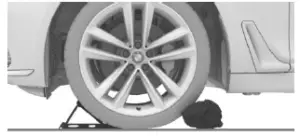
Place wheel chocks or other suitable objects in front and behind the wheel that is diagonal to the wheel to be changed.
On a slight downhill gradient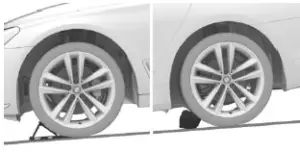
If you need to change a wheel on a slight downhill grade, place chocks and other suitable objects, for instance, rocks, under the proper side of the wheels of both the front and rear axles to block the car from rolling downhill.
Lug bolt lock
Principle
The wheel lug bolts have a special coding. The lug bolts can only be released with the adapter which matches the coding.
Overview
The adapter of the lug bolt lock is in the onboard vehicle tool kit or in a storage compart-ment close to the onboard vehicle tool kit.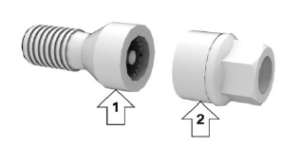
- Lug lock bolt, arrow 1.
- Adapter, arrow 2.
Unscrewing
- Attach the adapter to the lug lock bolt.
- Unscrew the lug lock bolt.
- Remove the adapter after unscrewing the lug bolt.
Screwing on
- Attach the adapter to the lug lock bolt. If necessary, turn the adapter until it fits on the lug lock bolt.
- Screw on the lug lock bolt. The tightening torque is 101 lbs ft/140 Nm.
- Remove the adapter and stow it after screwing on the lug bolt.
Preparing the vehicle
- Park the vehicle on solid and non-slip ground at a safe distance from road traffic.
- Turn on the hazard warning system.
- Set the parking brake.
- Engage a gear or move the selector lever to position P.
- As soon as permitted by the traffic flow, have all vehicle occupants get out and make sure that they remain outside the hazardous area such as behind a guardrail.
- Depending on the vehicle equipment, get wheel change tools and, if necessary, the emergency wheel from the vehicle.
- If necessary, set up a warning triangle or portable hazard warning light at an appropriate distance.
- Secure the vehicle additionally against rolling away.
- Loosen the lug bolts a half turn.
- Deactivate the air suspension level adjustment.
Jacking points
The jacking points are located at the indicated positions.
Jacking up the vehicle0
Warning
Hands and fingers can be jammed when using the jack. There is a risk of injury. Comply with the described hand position and do not change this position while using the jack.
- Hold the vehicle jack with one hand, ar-row 1, and grasp the jack crank handle or lever with your other hand, arrow 2.

- Insert the jack into the rectangular recess of the jacking point closest to the wheel to be changed.

- Extend the jack by turning the jack crank handle or lever clockwise.

- Take your hand away from the jack as soon as the jack is under load and continue turn-ing the jack crank handle or lever with one hand.
- Make sure that the car jack foot extends vertically and is at a right angle beneath the jacking point.
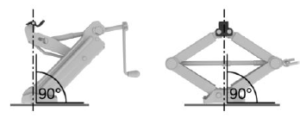
- Make sure that the car jack foot is vertical
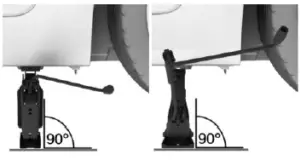
- Crank the vehicle up until the vehicle jack has the entire surface on the ground and the relevant wheel is a maximum 1.2 inches/3 cm above the ground.
Mounting a wheel
Warning
Unsuitable wheel studs, such as single-section wheel studs, may loosen or come off. The wheel may come loose during driving. There is a risk of an accident. Use only two section wheel studs that have been categorized as suitable for the respective wheel type by the manufacturer of the vehicle.
Mount one emergency wheel only, as required.
- Unscrew the lug bolts.
- Remove the wheel.
- Put the new wheel or emergency wheel on and screw in at least two lug bolts in a crosswise pattern until hand-tight.
When non-original light alloy wheels of the vehicle manufacturer are mounted, the ac-companying lug bolts may have to be used as well. - Hand-tighten the remaining lug bolts and tighten all lug bolts well in a crosswise pattern.
- Turn the jack crank handle counterclockwise to retract the jack and lower the vehicle.
- Remove the jack and stow it securely.
After the wheel change
- Tighten the lug bolts crosswise. The tightening torque is 101 lbs-ft/140 Nm.
- Stow the faulty wheel in the cargo area, if necessary.
- Check tire inflation pressure at the next opportunity and correct as needed.
- Re-initialize the flat tire monitor or reset the Tire Pressure Monitor.
- Check to make sure the lug bolts are tight with a calibrated torque wrench.
- Have the damaged tire renewed at the nearest authorized service center or another qualified service center or repair shop.
FAQ
The standard wheel size on the 2023 BMW X5 Plug-in Hybrid varies by trim level but typically ranges from 18 to 20 inches.
Yes, BMW often offers optional larger wheel sizes for those who prefer a more customized look or performance.
Yes, the X5 Plug-in Hybrid is typically available with all-season tires for versatile year-round driving.
Depending on the trim level and package options, performance tires may be available for enhanced handling and grip.
The recommended tire pressure can vary depending on the tire size and specific model configuration. It is advisable to refer to the vehicle’s manual or the tire placard inside the driver’s door for the correct tire pressure information.
The availability of a spare tire can depend on the specific trim level and options chosen. Some models may come with a spare tire, while others might have run-flat tires or a tire repair kit.
BMW often offers a variety of wheel and tire packages to allow buyers to customize the look and performance of their X5 Plug-in Hybrid.
Regular tire maintenance, including tire rotation, balancing, and alignment, is recommended to ensure even wear and optimal performance. Checking tire pressure regularly is also essential.
BMW frequently offers a range of wheel finishes and designs to suit various aesthetic preferences, from classic to sporty to elegant.
Yes, winter tire options are typically available for those who need enhanced traction and safety in snowy or icy conditions.
Yes, the X5 Plug-in Hybrid typically comes equipped with a TPMS to alert drivers to any significant changes in tire pressure.
The maximum load capacity can vary based on the specific tire size and type. It’s essential to refer to the tire specifications for this information.
BMW pimarily equips the X5 Plug-in Hybrid with tires designed for on-road performance and comfort, but all-terrain or off-road tire options may be available through aftermarket sources.
BMW often offers warranty coverage for its wheels and tires, and maintenance packages may be available for added peace of mind.
It’s possible to switch to larger or smaller wheels, but it’s essential to consult with a BMW dealership to ensure that the new wheels and tires are compatible with the vehicle’s specifications and do not affect performance or safety adversely.
Useful Link
View Full PDF: BMW X5 PLUG-IN HYBRID 2023 User Guide
Download Manual: https://www.bmwusa.com/owners-manuals.html
2023 BMW X5 Specs, Price, Features, Mileage (brochure)


